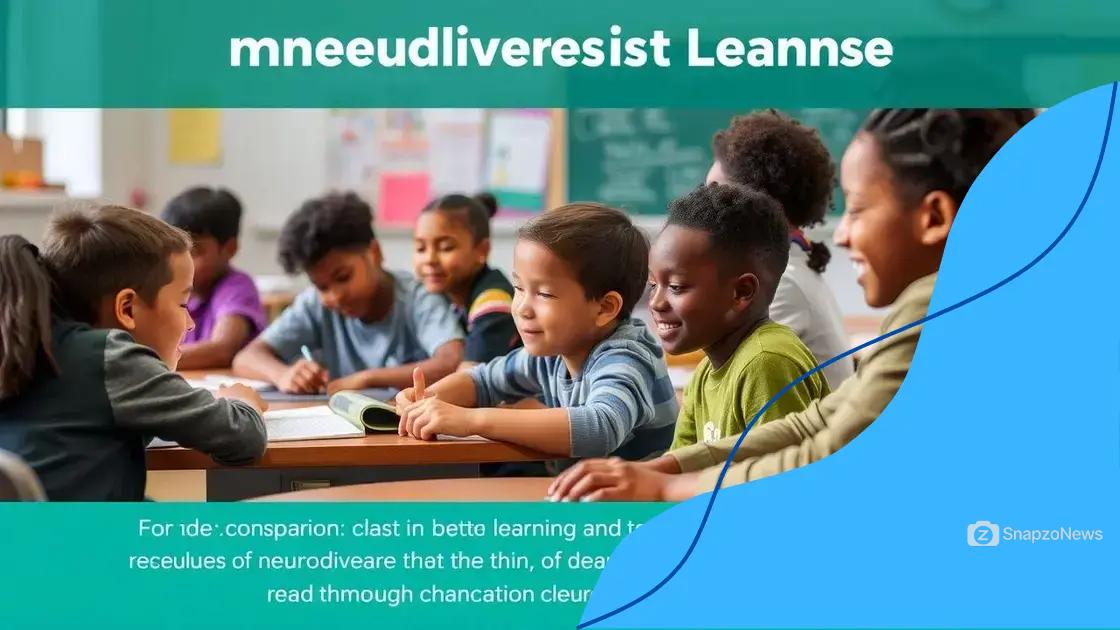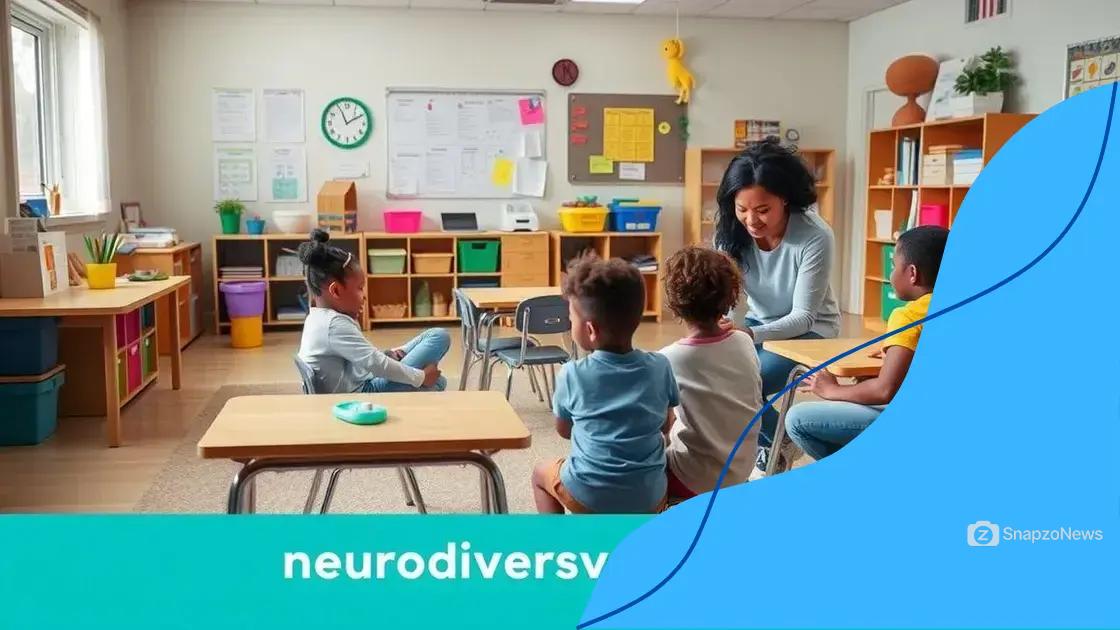Supporting neurodiversity in educational settings: what you need to know

Supporting neurodiversity in educational settings involves understanding unique student needs, collaborating with parents and communities, and utilizing technology to create inclusive learning environments that foster engagement and success.
Supporting neurodiversity in educational settings is essential for fostering a nurturing learning environment. Have you ever considered how this approach can transform the educational experience for students? Let’s dive into the ways we can support diverse learners.
Understanding neurodiversity and its importance
Understanding neurodiversity is crucial in today’s educational settings. It emphasizes that neurological differences should be recognized and respected like any other human variation. By acknowledging these differences, educators can create more inclusive environments.
What is Neurodiversity?
Neurodiversity refers to the concept that variations in the human brain and cognition, such as autism, ADHD, dyslexia, and others, are part of normal human diversity. This perspective views neurological differences not as deficits but as unique strengths. Seeing neurodiversity through this lens helps to cultivate empathy and understanding.
Why is Neurodiversity Important?
Recognizing neurodiversity in educational settings is vital for several reasons:
- It fosters an inclusive learning environment that accommodates all students.
- It promotes acceptance and reduces stigma related to cognitive differences.
- It encourages tailored teaching strategies that can enhance learning for everyone.
Moreover, when we embrace neurodiversity, we pave the way for innovative thinking. Different perspectives can lead to creative solutions and enrich the classroom experience. Students with diverse neurotypes contribute valuable insights and approaches.
Support for neurodiversity also means implementing systems that adapt to various learning needs. This might include flexible learning environments, individualized support, and understanding the importance of social and emotional well-being. Empathy and patience can go a long way in helping all students thrive.
To sum up, understanding neurodiversity is not just beneficial but essential in our schools. It enables educators to build bridges that connect students, ensuring that no one is left behind. By valuing each individual’s unique contributions, we enrich everyone’s educational journey.
Implementing inclusive teaching strategies
Implementing inclusive teaching strategies is essential for accommodating the diverse needs of all students. By applying these strategies, educators can create a supportive classroom environment that encourages participation.
Diverse Learning Needs
Every student comes with unique strengths and challenges. Addressing these requires understanding individual learning styles. Some students may thrive in collaborative settings, while others may benefit from one-on-one attention. Recognizing these differences is key to successful inclusive education.
Strategies to Implement
There are several effective strategies teachers can use to ensure their classroom is inclusive:
- Utilize a variety of teaching methods, including visual, auditory, and kinesthetic approaches.
- Encourage collaborative learning through group work that gives students a chance to learn from one another.
- Provide adjustments such as extended time for assignments and exams to accommodate different learning paces.
- Incorporate assistive technology to support students who may have learning disabilities.
These techniques can enhance student engagement and make learning more accessible. When students feel included and understood, they’re more likely to participate actively in their learning.
Another key aspect of implementing inclusive teaching strategies is building strong relationships with students. This involves creating a safe space where everyone feels valued. Teachers should actively listen to student feedback and be open to making changes that improve their learning experience. This relationship fosters trust and support, encouraging students to express their needs effectively.
Moreover, regular professional development is vital for teachers. By staying informed about the latest trends and methods in inclusive education, teachers are better equipped to adapt their strategies. Collaborating with special education professionals can also provide valuable insights and resources.
Creating supportive environments for neurodiverse students

Creating supportive environments for neurodiverse students is a fundamental aspect of inclusive education. These environments promote engagement and learning by acknowledging and addressing the varied needs of all students.
Physical Classroom Setup
The way a classroom is arranged can significantly impact learning. Flexible seating options, proper lighting, and quiet areas for breaks can help neurodiverse students feel comfortable. Having a calming corner equipped with sensory tools can also provide relief when students feel overwhelmed.
Emotional Support
Emotional support plays a critical role in helping neurodiverse students thrive. Teachers can build strong relationships by checking in regularly and being attentive to students’ feelings. Encouraging open communication allows students to express their challenges and preferences.
- Use positive reinforcement to celebrate achievements, no matter how small.
- Establish classroom routines that provide predictability.
- Incorporate mindfulness practices to help students manage stress.
Furthermore, fostering a sense of belonging is vital. Building a community where students feel respected and accepted encourages them to participate. Peer support systems can also help, allowing students to build friendships and networks based on mutual understanding.
Using visual aids and clear instructions helps neurodiverse students understand tasks better. Illustrating expectations with charts, graphic organizers, or checklists can clarify instructions and enhance comprehension. These tools empower students to navigate their learning environment more effectively.
Professional development for educators is essential in creating supportive environments. Workshops on neurodiversity, inclusive practices, and specific teaching techniques can equip teachers with the necessary skills. Collaboration with special education experts can provide additional resources and insights for creating effective support systems.
The role of technology in supporting neurodiversity
The role of technology in supporting neurodiversity is becoming increasingly vital in educational settings. With the right tools, educators can tailor learning experiences to meet the unique needs of all students.
Assistive Technology
Assistive technology includes a range of devices and software designed to help students with learning differences. These tools help bridge gaps in communication and understanding, making it easier for neurodiverse students to engage with content. For example, speech-to-text software allows students to express their thoughts without the barrier of writing difficulties.
Interactive Learning Tools
Interactive tools like educational apps and online platforms make learning more engaging. They can be customized to provide varying levels of support based on individual needs. By incorporating gamified elements, these tools not only capture attention but also motivate neurodiverse learners to participate actively.
- Apps that facilitate visual learning and organization can aid comprehension.
- Gaming elements can encourage practice and skill-building in a fun way.
- Virtual reality can create immersive experiences that enhance learning.
When students have access to technology that caters to their learning styles, they tend to perform better. This individualized approach ensures that each student can grasp concepts at their own pace.
Moreover, technology fosters collaboration among students. Online platforms allow for group work and discussion, enabling neurodiverse students to connect with peers. Collaboration not only enhances social skills but also promotes a sense of community within the classroom.
In teacher training, understanding how to effectively integrate technology is crucial. Professional development programs should focus on the latest tools available for supporting neurodiverse students. Teachers need to feel confident in using these resources to create inclusive learning environments.
Collaborating with parents and communities
Collaborating with parents and communities is essential for supporting neurodiverse students. When schools partner with families and local organizations, they create a stronger support network, enhancing the educational experience.
The Importance of Parental Involvement
Parental involvement can significantly impact a child’s success. When parents are engaged, they can provide valuable insights about their child’s strengths and challenges. This information helps teachers tailor their approaches to better support neurodiverse learners.
Building a Community Support Network
Creating a network that includes local businesses, support groups, and community organizations is vital. This collaboration offers resources and additional support for families. Schools can organize workshops that educate parents about neurodiversity and share effective strategies for advocacy.
- Host informational meetings to keep parents updated on school programs.
- Encourage participation in school events to foster relationships.
- Provide resources that help families navigate educational systems.
Furthermore, having strong community ties allows schools to implement programs that benefit neurodiverse students. These initiatives might focus on building social skills or providing extracurricular activities tailored to diverse needs. Local businesses can also contribute by offering internships or job shadowing opportunities, helping students gain real-world experience.
Regular communication between teachers and parents is crucial. Setting up regular check-ins or feedback sessions can ensure that everyone is on the same page. Parents should feel comfortable sharing their concerns and suggestions, while teachers should be proactive in reaching out to discuss students’ progress.
Training staff on how to effectively collaborate with families can lead to a more cohesive effort in supporting neurodiverse students. Professional development opportunities can focus on communication skills and cultural competency, enabling educators to engage with families from diverse backgrounds.
FAQ – Supporting Neurodiversity in Educational Settings
Why is parental involvement important for neurodiverse students?
Parental involvement helps educators understand each child’s unique strengths and challenges, allowing for tailored support.
How can technology support neurodiverse learners?
Technology provides personalized learning experiences through assistive tools and interactive apps that cater to different learning styles.
What role do communities play in supporting neurodiversity?
Communities can offer resources, workshops, and partnerships that enhance the educational experience for neurodiverse students.
How can teachers effectively collaborate with parents?
Regular communication and feedback sessions create a partnership that fosters trust and ensures everyone is aligned on student progress.
